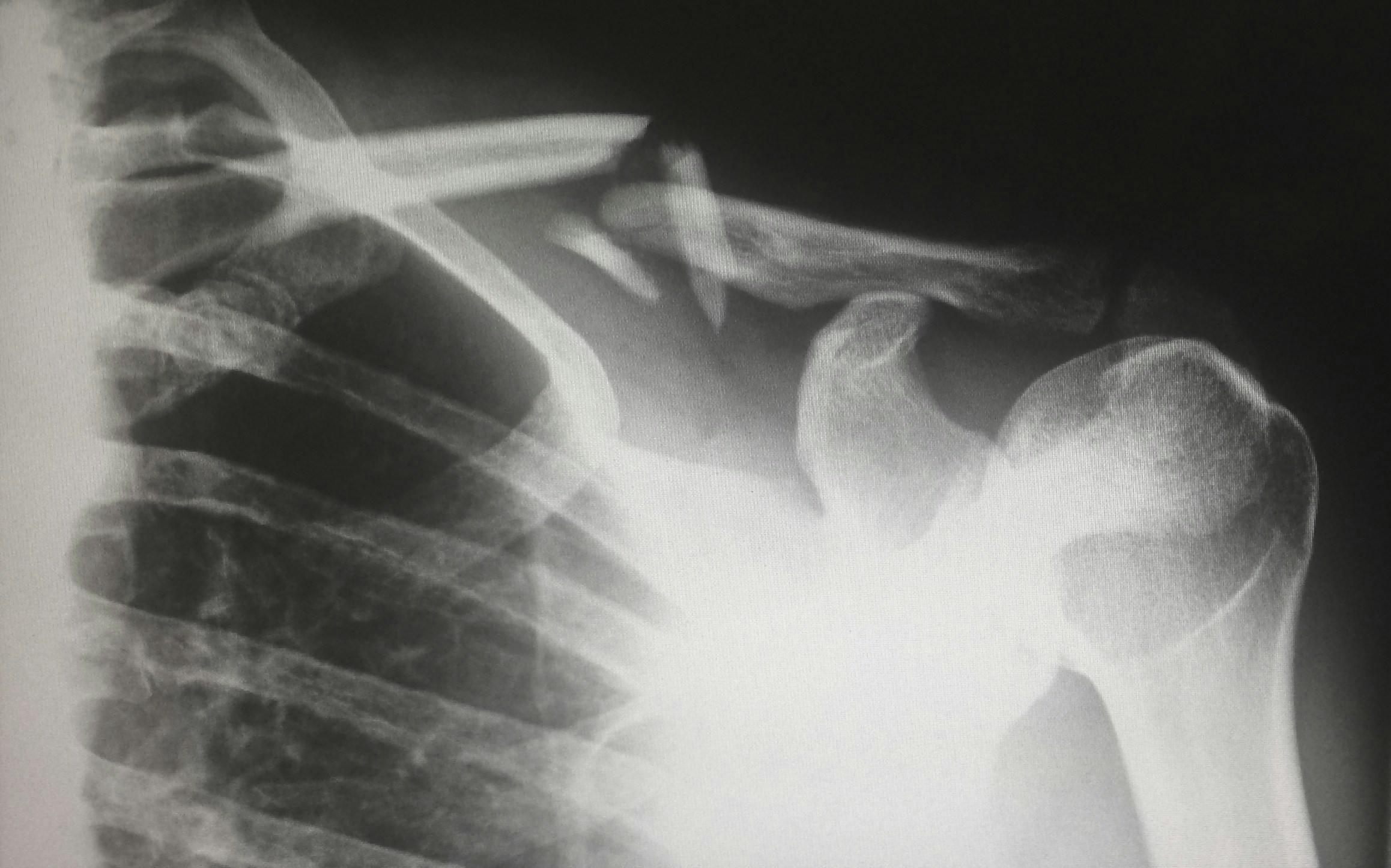Bone cancer is a malignant disease involving various types of cartilage and bone in the human body. Primary bone cancers are rare; much more often, bone cancer follows metastasis. Bone cancers are mainly divided into benign and malignant tumors.
Patients usually present to the doctor with suspected musculoskeletal injuries. Therefore, the first non-specific symptoms associated with bone cancer symptoms should not be underestimated. For the diagnostic goal of bone cancer, radiographic examination is used. After treatment, effective rehabilitation is essential to improve the affected limb. The prognosis also depends on the type of cancer and the metastases present.

The bone microenvironment![]() is a common site of cancer metastasis, mainly of prostate and breast cancer cells. Cancer cells quickly invade and colonize the bone. They cause many changes in the bone structure, including altering resorption and bone formation to stimulate their growth. Primary and secondary bone tumors are rare, and a meager percentage involve primary ones. By dividing bone cancers into primary and secondary cancers, types of bone cancer can be distinguished.
is a common site of cancer metastasis, mainly of prostate and breast cancer cells. Cancer cells quickly invade and colonize the bone. They cause many changes in the bone structure, including altering resorption and bone formation to stimulate their growth. Primary and secondary bone tumors are rare, and a meager percentage involve primary ones. By dividing bone cancers into primary and secondary cancers, types of bone cancer can be distinguished.
Bone cancer can be primary, meaning that it arises in the bone tissue directly, without the presence of a different type of cancer from which it has metastasized. Primary bone cancers are rare, with a higher proportion occurring in children and adolescents![]() . Malignant bone tumors are associated with aggressive and rapid growth. Despite the implementation of treatment, malignant primary bone tumors are prone to recurrence. The common types include:
. Malignant bone tumors are associated with aggressive and rapid growth. Despite the implementation of treatment, malignant primary bone tumors are prone to recurrence. The common types include:
Osteosarcoma is a bone tumor that most commonly occurs in children and young adults. Osteosarcoma is a malignant tumor of bone tissue that most commonly affects the long-term bones. This type of bone tumor often occurs in the knee joint and the humerus. The disease usually presents in a malignant form. The exact cause of osteosarcoma remains unknown. However, one predisposing factor is the rapid growth of bones![]() during childhood.
during childhood.
Chondrosarcoma (CS) is a rare primary bone tumor that may arise from a different, initially benign, bone lesion or may immediately have a malignant form. The cancer is mainly localized in the femur, humerus, ribs, and on the surface of the pelvis. Chondrosarcoma metastasizes via the blood route, most commonly to the lungs in the first instance. Genetic diseases and bone diseases may predispose to this type of bone tumor.
Ewing's sarcoma develops in bone and soft tissue, smooth and striated muscle, connective tissue, and cartilage. Typically, the cancer develops in the thigh, pelvis, and chest wall. During the disease, characteristic genetic mutations in specific genes are observed. The disease is most often diagnosed in the teenage years.

It is more common for bone cancer to arise as a result of metastases![]() from different organs occupied by the tumor. Metastatic lesions occur due to an ongoing cancer process in a different part of the body. The primary focus of bone metastases can be various types of cancer. Secondary tumors comprise the vast majority of bone tumor cases. The unique microenvironment of bone provides a preferential site for many cancers to metastasize. Bone metastases are classified into the following types:
from different organs occupied by the tumor. Metastatic lesions occur due to an ongoing cancer process in a different part of the body. The primary focus of bone metastases can be various types of cancer. Secondary tumors comprise the vast majority of bone tumor cases. The unique microenvironment of bone provides a preferential site for many cancers to metastasize. Bone metastases are classified into the following types:
This type of bone tumor is characterized by the destruction of standard bone structure. Parathyroid hormone-related peptide plays a significant role in the development of osteolytic lesions. Most cancer metastases are of the osteolytic type. Osteolytic bone tumors arise from metastases of diseases such as multiple myeloma (MM)![]() , lung cancer
, lung cancer![]() , or thyroid cancer
, or thyroid cancer![]() , among others.
, among others.
By a different name, the sclerotic type of metastasis involves the deposition of new bone; however, the mechanisms of osteoblastic metastasis are poorly understood. New bone formation is not necessarily preceded by bone resorption. Diseases such as prostate cancer![]() , lung cancer
, lung cancer![]() , or Hodgkin's lymphoma
, or Hodgkin's lymphoma![]() cause osteoblastic metastases to the bone.
cause osteoblastic metastases to the bone.
Osteolytic and osteoblastic lesions can co-occur, in which case one speaks of mixed bone metastases. Metastases of the mixed type occur in tumors such as gastrointestinal and squamous cell carcinomas![]() . Mixed types of metastases are more common in women.
. Mixed types of metastases are more common in women.

Bone tumors are most often associated with pain, which is why symptoms of cancer are frequently mistaken for mechanical trauma. Noticing worrying signs should suggest seeking medical attention. It is essential among children, as bone tumors are more common in this group. Therefore, do not underestimate the concern if you notice the following symptoms in yourself or your loved ones:
Initially, bone cancer does not produce any symptoms. Bone pain appears as the first and most typical symptom. Bone cancer lesions often cause pain, which results in spinal instability and reduced mobility. Bone cancer pain is usually described as dull, constant, and progressively worsening over time. As the cancer progresses, severe spontaneous pain![]() often occurs. The very severe pain symptoms of bone tumors are alarming and significantly reduce patients' quality of life. Bone pain can be exacerbated at various times, for example, in the morning or at night, as well as after physical activity.
often occurs. The very severe pain symptoms of bone tumors are alarming and significantly reduce patients' quality of life. Bone pain can be exacerbated at various times, for example, in the morning or at night, as well as after physical activity.
In addition to pain, swelling may occur at the site of the bone occupied by the tumor. Such symptoms are often mistaken for mechanical trauma, especially if the patient regularly plays any sport that exposes them to injury. There may also be contractures and tingling in the limbs. In addition to swelling, there is a general weakening of the bones, which can cause fractures. Patients with bone tumors are much more prone to bone fractures![]() and inflammation. As the disease progresses, the bones can become deformed, and the tumor and swelling contribute to it. The consequence of bone cancer is a decline in patients' performance.
and inflammation. As the disease progresses, the bones can become deformed, and the tumor and swelling contribute to it. The consequence of bone cancer is a decline in patients' performance.

Additional symptoms, such as weight loss, are also observed in bone tumors. The cancerous tumor initiates inflammation in the patient's body. Tumour cells, which are constantly multiplying, secrete a type of protein called cytokine, which can mimic the action of substances that suppress appetite and speed up metabolism and, thus, energy consumption. This is why in cancer, including bone tumors, weight loss is often noticed in patients.
In patients with bone tumors, anemia is found in blood tests. Anemia is a condition with a deficiency of hemoglobin, the red pigment of the blood. The development of cancer often causes anemia in the human body. In addition to anemia, hypercalcemia![]() may also occur in bone tumors. Hypercalcaemia is a disorder of the body's mineral metabolism defined as an excessively high concentration of calcium in the blood.
may also occur in bone tumors. Hypercalcaemia is a disorder of the body's mineral metabolism defined as an excessively high concentration of calcium in the blood.
A rare sign of bone cancer is enlarged regional lymph nodes. Enlarged lymph nodes may be a symptom of progressive cancer and may signal the appearance of cancer metastases. The most common locations for metastases are regional lymph nodes, i.e., nodes near the primary focus.
The first step in diagnosis is always the medical history, which provides information on the patient's age. As far as precise medical examinations are concerned, diagnostic imaging is mainly used to diagnose bone tumors.

The first to be done to diagnose bone cancer is usually an X-ray. Radiography is a readily available technique for assessing bone condition. However, the sensitivity of ordinary radiography is low, as cancerous lesions may not appear on the X-ray in the early stages. However, X-rays are helpful because various tissues absorb radiation, allowing one to see bone destruction.
A scintigraphic examination is also used in bone tumors. Bone scintigraphy is a susceptible method. Bone scintigraphy is a functional study showing the metabolism of bone tissue and, indirectly, some morphological changes in the skeletal system. Bone scintigraphy is very helpful in diagnosing skeletal disorders such as cancer metastases to the bone and bone inflammation.
Computed tomography (CT) scanning is also possible to diagnose bone cancer. CT scanning is highly sensitive and produces excellent soft tissue visibility and contrast images. Bone destruction is visible, and any soft tissue extension of bone metastases is easily visualized. CT is beneficial for localizing lesions for biopsy.
Positron emission tomography (PET) is another helpful imaging test for bone tumors. PET detects the presence of cancer by quantifying metabolic activity. The test is superior to scintigraphy in detecting bone metastases from lung cancer. However, it has less accuracy in bone metastases from kidney and prostate cancer cases, as these diseases are slower to progress. PET shows sites of bone resorption undetected by conventional diagnostic methods. In addition, it can reveal metastases to sites other than bone.
A diagnostic biopsy is necessary before surgery, which is a standard treatment for bone cancer. The biopsy must be performed accurately and optimally, and it gives a definitive diagnosis. A bone biopsy involves collecting material for examination under a microscope. A biopsy of a bone tumor should be performed under the guidance of imaging studies.
A multidisciplinary team with expertise in treating primary and secondary bone tumors is crucial. The team comprises a core group of specialists, such as oncologists, radiologists, pediatricians, and surgeons. This is important because the detection and treatment of bone cancer are complex processes. Treatment methods for bone cancer are various and depend on the type and location of the cancerous lesions.

A biopsy is necessary before surgical treatment of a bone tumor. It involves removing the focus of the disease along with a margin of healthy tissue. In the case of advanced lesions, surgery is extensive; in challenging situations, it involves the excision of a large section of bone or even amputation of the limb. Operative treatment is indicated for long-term bone and hip fractures. A new therapeutic option is stereotactic radiosurgery![]() , which treats metastatic bone tumors. Early treatment of lesions can avoid the need for extensive surgery.
, which treats metastatic bone tumors. Early treatment of lesions can avoid the need for extensive surgery.
It is another method of treating bone cancer, usually used as an adjunctive method, and is applied after surgery. Chemotherapy can also be an initial treatment. The technique involves destroying tissue by selecting chemicals contained in drugs. Chemotherapy regimens have the goal of causing tumor necrosis, reducing tumor size and the possibility of metastasis and recurrence. Chemotherapeutic drugs of proven efficacy used as adjunctive therapy effectively reduce the number of postoperative metastases.
Another method of treating bone tumors is various types of radiotherapy. Local radiotherapy is used to treat bone metastases and is highly effective in treating pain. Wide-field radiotherapy can be used for extensive symptomatic bone metastases. Radiotherapy involves the action of X-rays on cancer cells, causing them to die.
There are various methods of treating cancers involving bone tissue. Options are tailored to the individual patient's needs. In the case of bone tumors, a common symptom is severe pain, which significantly reduces patients' quality of life. Consequently, it also involves treatment methods to alleviate unpleasant symptoms. Various types of painkillers are often used, but pain relief is also provided by targeted treatment, i.e., surgery, chemotherapy, or radiotherapy. In addition to this, drugs such as bisphosphonates![]() are often used in the treatment of bone cancer. These are good for both relieving bone pain and reducing complications.
are often used in the treatment of bone cancer. These are good for both relieving bone pain and reducing complications.
The prognosis can vary depending on the type of bone tumor. An important prognostic indicator is the presence of metastases at the time of diagnosis. In contrast, the leading predictive factor is the level of the cancer. If the tumor has a low level of malignancy, the prognosis is usually favorable. Primary bone cancer also has a much better prognosis than secondary bone cancer caused by metastases.
Bone cancer is a dangerous disease due to the damaging nature of the cancerous changes. Bone cancer can be divided into various categories; it is a broad group of diseases. Primary and secondary bone cancers are mostly mentioned. Different risk factors predispose to bone cancer. Symptoms usually concern limb bone pain, significantly reducing the quality of life. A correct diagnosis based on imaging tests can quickly detect bone cancer. It can then bring about treatment based on surgery, chemotherapy, and radiotherapy.
Table of Contents

Brain tumors are abnormal growths located in the brain. It can be malignant or benign. Symptoms and treatment depend on… read more »

Liver cancer is a tumor that is found in the liver. The most common symptoms include jaundice, unexpected weight loss,… read more »

Breast cancer is one of the most common cancers worldwide. It most often affects women. How is it diagnosed? Who… read more »

Zollinger-Ellison Syndrome is a condition that can cause uncharacteristic symptoms. Treatment is important as the disease can be fatal. Learn… read more »

Cancer is the second most common cause of death in the US. It can affect any body part and spread… read more »

Glioblastoma is a brain cancer with a poor prognosis. Discover the first signs of the disease and the latest treatments.… read more »

Colon cancer is a common disease with a high mortality rate. Find out how to recognise the first signs of… read more »

The bone marrow is an important part of the human body. Learn to recognise diseases that can occur when the… read more »

Bone fracture is referred to by specialists as either a crack or break in the bone, traditionally caused by excessive… read more »